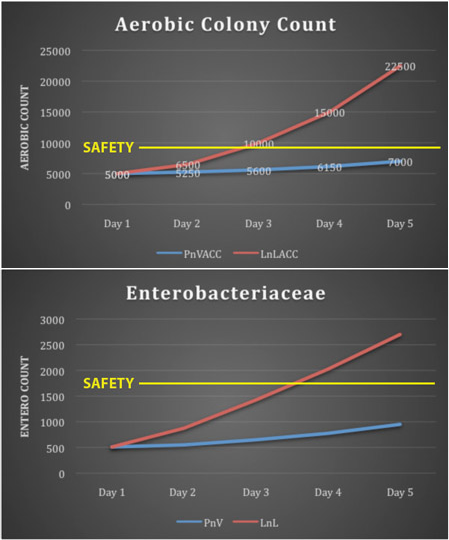THE SCIENCE BEHIND PAC ‘N VAC FOOD STORAGE
Food generally deteriorates due to specific, recognised factors. Some of these we can control, for example:
- temperature, by storing food in a fridge or completely stopping the growth of any microbes by freezing
- light, by storing food in a fridge where there is no light
How Pac ‘n Vac vacuum food storage boxes inhibit the growth of food-damaging factors

Comparing the aerobic colony and enterobacteriaceae counts over a standard 5-day refrigeration period in an ordinary plastic food storage box (red) and a Pac ‘n Vac vacuum food container (blue) against the recommended safety level (yellow line).
What Pac ‘n Vac vacuum food storage boxes add to the list is the ability to control the amount of oxygen and air the foodstuff is exposed to. By expelling air from the box, the foodstuff contained in it stays fresher for longer because the reduction in atmospheric air created with Pac ‘n Vac’s instant vacuum significantly inhibits the growth of microorganisms. To see how to use a Pac n’ Vac vacuum food container click here>
Pac ‘n Vac had the vacuum food boxes tested at Public Health England for Aerobic Colony Count and Enterobacteriaceae. It is known that chicken is especially susceptible to microbial activity, so the tests carried out included this product. The product was tested when it was delivered, under strict temperature conditions and then re-tested at the end of 5 days – the normal maximum cycle for keeping supermarket fresh products. The results showed that the colony count increased at a substantially slower rate when the Pac ‘n Vac vacuum was present. Indeed after 3 days in the ordinary plastic food storage container, some products – particularly chicken – were beyond their recommended shelf life whereas if they had been stored in a Pac ‘n Vac box they would have lasted at least five more days. NOTE the charts below are the average for all tested products – some products last longer than others.
How Pac ‘n Vac boxes create an instant food-saving vacuum

As you push down on the container you force air out through the silicon button valve without the need for suction devices, bags or gadgets. When the pressure is released the resultant higher pressure outside the container forces the valve shut, creating a seal and a vacuum inside the box. Watch the following video to see how it works.


